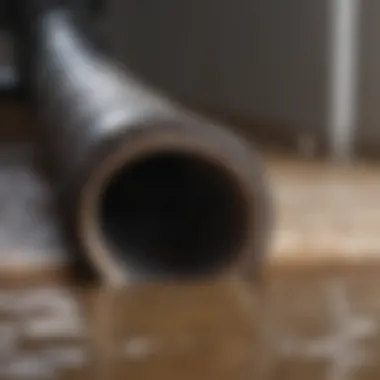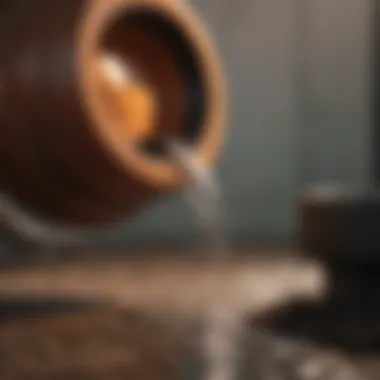Mastering Drain Cleaning: Techniques & Tools


Intro
Clogged drain pipes are not merely an inconvenience; they can escalate into serious plumbing issues if left unattended. Understanding the complexities of drainage systems is crucial for homeowners who wish to maintain their plumbing effectively. Frequently, drains collect debris, grease, and other materials, leading to blockages.
This article aims to demystify the cleaning process, clarifying methods and tools needed to tackle clogs successfully. It is tailored for those who prefer to handle such matters independently, without requiring service from professionals. A proactive approach to drain maintenance can save time and money in the long run.
Understanding Clogs
Clogs in drain pipes typically arise from various sources. Common culprits include:
- Hair and soap residue in bathroom drains.
- Food particles and grease in kitchen sinks.
- Foreign objects lodged in toilets.
Recognizing these sources is the first step toward effective prevention and cleaning. Regular maintenance can mitigate the risk of severe clogs.
Effective Cleaning Methods
Cleaning clogged drain pipes can be tackled through several techniques, each suited for different types of blockages. Here are some effective methods:
Boiling Water
This is a straightforward approach for grease-related clogs.
- Boil a kettle of water.
- Pour it directly into the affected drain.
- Repeat if necessary.
Baking Soda and Vinegar
This method leverages a chemical reaction to clear minor blockages.
- Pour half a cup of baking soda down the drain.
- Follow with half a cup of vinegar.
- Allow it to fizz and sit for about 30 minutes.
- Flush with hot water.
Plumber's Snake
For persistent clogs, a plumber's snake can be extremely helpful. It reaches deep into pipes.
- Insert the snake into the drain until you feel resistance.
- Turn the handle to break up the clog.
- Pull the snake out and flush the drain with water.
"Regular maintenance and prompt action can prevent the need for extensive repairs."
Tools for Drain Cleaning
Certain tools facilitate effective cleaning of drain pipes. Familiarizing oneself with these tools is essential:
- Plunger: Useful for creating suction to dislodge blockages in toilets and sinks.
- Drain auger: A versatile tool for reaching deeper clogs.
- Wet/dry vacuum: Can be effective for sucking out debris from clogged drains.
Preventive Measures
Practicing preventive maintenance can greatly reduce the occurrence of clogs. Consider these tips:
- Regularly clean sink strainers.
- Avoid pouring grease down the drain.
- Use drain covers to catch hair and larger debris.
Maintaining unclogged drain pipes often requires diligence but proves beneficial. By understanding the techniques, tools, and preventive measures, homeowners can foster a cleaner plumbing system.
Understanding Clogged Drain Pipes
Understanding clogged drain pipes is essential for any homeowner or property manager. It provides the foundation for effective plumbing maintenance and ensures that your property remains functional and free of common drainage issues. Knowledge about clogged drains not only equips you with the information needed to address problems promptly but also emphasizes the value of preventive measures that can save you both time and money.
Common Causes of Clogs
Several factors contribute to the formation of clogs in drain pipes. Among these, the most prevalent include:
- Hair: Long strands or clumps of hair often catch in drain pipes, especially in bathrooms.
- Grease and Oil: When poured down the kitchen sink, grease hardens and sticks to the pipe walls, creating thick buildup over time.
- Food Particles: Small bits of food can accumulate and combine with other debris, leading to blockages.
- Soap Residue: Soap can leave behind residue that gradually forms soap scum, which obstructs drains.
- Foreign Objects: Items such as toys, sanitary products, and other mislaid objects can lodge in pipes, halting proper drainage.


Addressing these common causes proactively can significantly reduce the incidence of clogs.
Signs of a Clogged Drain
Recognizing the signs of a clogged drain early can help in addressing issues before they escalate. Key indicators include:
- Slow Drainage: Water takes longer than usual to drain, often pooling in sinks or bathtubs.
- Unpleasant Odors: Foul smells emanating from drains suggest a buildup of waste just beneath the surface.
- Gurgling Sounds: A gurgling noise when water drains can indicate that air is trapped, often signaling a blockage.
- Water Backups: Water rising back into sinks or tubs can indicate severe clogging further down the pipe.
Being aware of these signs can aid in identifying a problem before it causes further damage to your plumbing system.
Potential Consequences of Ignoring Clogs
Failing to deal with clogs can lead to several serious consequences that can impact both your home and wallet:
- Water Damage: Full blockages can cause water to overflow and damage floors, walls, and foundations.
- Increased Repair Costs: The longer clogs remain, the more extensive the damage can become, leading to pricey repairs.
- Health Hazards: Standing water and waste buildup can create unsanitary conditions, promoting mold and bacteria growth.
- Decreased Property Value: Persistent drainage issues can deter potential buyers, negatively impacting your property's value.
Ignoring the signs of clogged drains invites a host of problems, making regular maintenance and timely action critical for property health.
"An informed homeowner is better equipped to prevent and address plumbing issues, safeguarding their investment."
drainpipes.com/maintenance
Assessing Your Plumbing System
To effectively tackle clogged drain pipes, assessing your plumbing system is crucial. This step allows homeowners to identify problem areas that might be causing repeated clogs. A robust plumbing assessment can save time, effort, and potential costs associated with fixing serious issues.
Identifying Problem Areas
Locating the source of recurrent clogs is the first step in plumbing assessment. Inspect the following areas:
- Kitchen Sink: Food waste or grease may accumulate in drains.
- Bathroom Sink and Shower: Hair and soap scum are common culprits.
- Toilets: Excessive toilet paper usage can lead to blockages.
- Basement Drains: These may be affected by root intrusion or sediment buildup.
Examine the water drainage in these areas. If water drains slowly or backs up, it indicates a problem. A visual inspection can help identify the location and type of blockage. Using a flashlight can assist in seeing deeper into the plumbing structure.
Choosing the Right Cleaning Approach
Once problem areas are identified, selecting a suitable cleaning method is important. Different types of blockages require specific approaches:
- Minor Clogs: These may be effectively managed with a plunger or a drain snake. Both tools can break up most simple blockages quickly.
- Moderate Blockages: For clogs that resist basic tools, a chemical drain cleaner may be employed. However, choosing a solution based on the material of your pipes is essential to avoid damage.
- Severe Clogs: Persistent clogs might necessitate professional intervention. Observing symptoms like strange sounds or persistent odors can signpost the need for expert help.
Always remember: The right approach will depend on the severity and type of blockage, which is why thorough assessment is vital.
Through careful evaluation of plumbing conditions and thorough understanding of possible cleaning strategies, homeowners can maintain optimal drainage in their homes.
Manual Cleaning Techniques
Manual cleaning techniques are fundamental for maintaining a plumbing system. These methods use physical actions to clear clogs, which can be highly effective and often less hazardous than chemical drain cleaners. Learning to use the correct tools and applying proper techniques can save homeowners time and money while ensuring their drainage systems operate effectively.
When clogs occur, many individuals may rush to use chemical solutions without exploring manual options. However, manual techniques often provide immediate relief and prevent further complications. They also require minimal investment in specialized equipment. Below are key techniques:
Using a Plunger
The plunger is one of the simplest and most widely recognized tools for unclogging drains. Its effectiveness stems from its ability to create pressure and suction, which can dislodge blockages lodged in pipes. To use a plunger effectively:
- Choose the Right Type: It’s essential to use a flange plunger for toilets and a cup plunger for sinks and tubs.
- Seal the Drain: Ensure that the plunger entirely covers the drain opening. This step is vital for creating a good seal.
- Apply Plunging Motion: Begin with several quick thrusts downward, followed by a slow pull back. Repeat this process several times before removing the plunger.
This method is straightforward and often successful against moderate clogs. However, in severe cases, multiple attempts might be necessary.
Snake and Auger Tools
For more stubborn clogs, a drain snake or auger presents a more powerful solution. These tools are designed to reach deeper into the plumbing system, interacting directly with the blockage.
- Drain Snake: A drain snake has a flexible metal cable that can navigate through bends in the pipe. To use it:
- Auger: An auger can tackle more significant buildups in larger drains. These are often more robust than snakes and can reach significant depths. To operate the auger:


- Insert the snake into the drain until resistance is felt.
- Rotate the handle. This action helps break apart the clog or grab any debris.
- Slowly retract the snake while rotating it to extract the clogged material.
- Insert the head into the drain and start turning the handle.
- Continue pushing until the clog is cleared or the auger feels free.
Utilizing these tools allows users to address more complex problems without relying on chemicals. Although purchasing a good-quality snake or auger involves more upfront cost, they are often a worthwhile investment.
Removing and Cleaning Fixtures
In situations where a clog is persistent, removing and cleaning fixtures may be required. This process provides insight into the source of the problem. It also removes any visible blockages. Fixtures such as sink traps can often accumulate debris that leads to clogs. To proceed:
- Turn Off the Water Supply: This step is crucial for avoiding unexpected spills.
- Remove Fixtures: Carefully detach fixtures like sink traps. Keep a bucket ready to catch any residual water.
- Clean Thoroughly: Utilize a brush or cloth to remove build-up inside the trap. This action can help identify any persistent blockages.
Cleaning fixtures may not only resolve current issues but also help in understanding maintenance needs in the future. Addressing clogs promptly encourages healthy plumbing habits and extends the longevity of drainage systems.
Keeping drains clear through manual cleaning techniques ultimately saves time and reduces the possibility of expensive repairs.
Understanding these manual techniques equips homeowners with the knowledge needed to tackle minor clogs efficiently. With practice, these skills can contribute significantly to a well-functioning plumbing system.
Chemical Cleaning Solutions
In the realm of unclogging drain pipes, chemical cleaning solutions serve a pivotal role. Their significance lies not only in their effectiveness but also in their ease of use. These products can quickly dissolve blockages that may be difficult to remove through manual methods. Particularly in cases where a clog persists despite traditional cleaning techniques, these chemical solutions offer an alternative approach.
Using chemical agents allows individuals to address issues without extensive labor or special tools. However, the application must be approached with caution. Understanding the types of chemical solutions and their proper use is essential to prevent potential damage to plumbing systems and to ensure the safety of users.
Commercial Drain Cleaners
Commercial drain cleaners are pre-formulated products designed for easy application. They commonly contain active ingredients such as sodium hydroxide or sulfuric acid, both known for their effectiveness in breaking down organic material like grease, hair, and soap scum. Many users favor these options due to their convenience and quick action.
When utilizing commercial drain cleaners, it is crucial to select a product that fits the specific type of clog. Some cleaners are formulated specifically for kitchen sinks, while others may target bathroom drains.
Considerations:
- Always read the label for specific instructions.
- Avoid mixing different cleaners, as reactions can produce harmful gases.
- Allow adequate time for the product to work before rinsing.
Homemade Cleaning Solutions
For those who prefer a more natural approach, homemade cleaning solutions can be just as effective. Common kitchen ingredients like baking soda, vinegar, and salt can create a powerful cleaning concoction. This method is less harsh on pipes compared to some commercial options and is often more budget-friendly.
A typical homemade solution involves pouring a cup of baking soda followed by a cup of vinegar down the drain. This combination produces a fizzing action that can help to dislodge clogs, particularly those caused by organic material. After allowing it to sit for 30 minutes, flushing the drain with hot water can help clear the remaining debris.
Benefits of Homemade Solutions:
- Eco-friendly and non-toxic.
- Inexpensive and easily accessible materials.
- Minimizes potential damage to plumbing systems.
Proper Usage and Safety Precautions
Regardless of the cleaning method chosen, adhering to proper usage and safety precautions is paramount. Chemical cleaners often come with a set of safety warnings that must be followed to ensure safe application. Here are some key points to remember:
"Always prioritize safety when dealing with chemical products to prevent accidents and injuries."
- Ventilation: Ensure good airflow in the area where you are applying the chemical. Open windows and doors if necessary.
- Protective Gear: Wear gloves and goggles to shield your skin and eyes from splashes.
- Storage: Keep chemicals away from children and pets. Store in a cool, dry place, properly labeled.
- Disposal: Dispose of unused products according to local regulations, as some chemicals are hazardous to the environment.
A mindful approach to cleaning can significantly enhance the efficiency of your plumbing system. Each method, whether chemical or manual, brings its unique advantages. Employing the right techniques will not only solve current issues but also contribute to effective long-term maintenance.
Preventive Measures
Preventive measures are often overlooked until a problem arises. These practices are crucial in maintaining a tidy plumbing system and avoiding severe blockages. By adopting certain habits and tools, you can significantly minimize the occurrences of clogged drain pipes.
Regular Maintenance Practices
Implementing regular maintenance is key for a healthy plumbing system. Here are some practices that can help:


- Routine Inspections: Check your drains periodically. Look for visible debris and be aware of any slow drainage signs, which may suggest early clog formation.
- Flushing Drains: Periodically flush your drains with hot water. This simple action helps dissolve greasy residues that accumulate over time.
- Professional Check-ups: Schedule annual plumbing inspections with specialists. This prevents small issues from becoming significant problems.
Alongside these methods, always keep an eye on your water bill. A sudden spike may indicate a leak or another plumbing issue that needs attention.
Proper Disposal of Household Waste
Disposing of household waste correctly is essential to prevent drain issues. Many people are unaware of what should and should not go down the drain:
- Avoid Grease: Never pour cooking oil or grease down the sink. This substance hardens, constricting pipes over time.
- Food Scraps: Use a compost bin for food scraps instead of the garbage disposal. Most disposals can handle only small quantities without jamming.
- Hygiene Products: Items like wipes, cotton swabs, and sanitary products should never be flushed down toilets. Dispose of them in appropriate waste bins instead.
Being mindful of what you dispose of will contribute significantly to reducing the risk of clogs.
Installing Drain Screens and Traps
Another practical solution is installing drain screens and traps in strategic locations. These tools are effective at filtering out debris before they enter the plumbing system:
- Mesh Screens: For kitchen sinks and bathtubs, mesh screens effectively capture hair, food particles, and other debris. Regularly clean them to ensure good flow.
- Traps: Installing traps can be helpful, especially in showers and sinks. They trap hair and soap scum, which are common culprits of clogs.
These preventive strategies not only maintain your plumbing efficiency but can also save you money in repair costs down the line.
Preventive measures are about ensuring a longer lifespan for your plumbing system while also avoiding the inconvenience caused by drain emergencies.
When to Call a Professional
In the pursuit of maintaining a functional plumbing system, some clogs may exceed the capabilities of DIY methods. Recognizing when to engage a professional can mitigate risks and prevent further complications.
Understanding Severe Clogs
Sometimes, clogs can become severe and resistant to basic cleaning techniques. If you find that a plunger or snake does not resolve the blockage after repeated attempts, it may be time to consult a professional. Severe clogs often indicate deeper issues within the plumbing system. For example, tree roots invading the sewer line or extensive buildup of grease can lead to persistent blockages.
Attempting to resolve these issues yourself can lead to more significant damage that is costly to repair. Furthermore, waiting too long to call for help can result in water damage, mold growth, or even structural damage to your property.
Professional intervention not only addresses the immediate problem but also raises awareness of any underlying issues that could develop in the future.
Identifying Plumbing Issues Beyond Clogs
Not all plumbing problems are related to blockage. There are instances when the symptoms of a clog may mask deeper plumbing issues. For example, frequent clogs could signal a failing sewer line or corrosion in older pipes.
If you detect unusual sounds, strange odors, or consistent drainage problems, these may not only be a simple clog. Sometimes, the plumbing may require a professional's insight to assess the overall condition of the pipes and the drainage system.
Here are some signs that indicate the need for professional help:
- Unexplained water pooling around fixtures.
- Gurgling sounds from the drains.
- Multiple fixtures draining slowly at once.
- Water backing up in sinks or tubs after flushing the toilet.
When faced with these issues, it is crucial to act promptly. An expert can provide a thorough inspection and potentially save you from extensive repairs down the line.
Ending
In the realm of home maintenance, understanding how to effectively deal with clogged drain pipes cannot be overstated. This article provided insight into various strategies for addressing clogs and maintaining plumbing systems. With knowledge of different cleaning techniques and the importance of regular upkeep, homeowners can avoid many of the costly repairs linked to neglected drain systems.
Recap of Effective Strategies
A successful approach to drain management involves several key actions:
- Manual Cleaning Techniques: Using a plunger or snake can often dislodge minor clogs without the need for harsh chemicals.
- Chemical Solutions: When necessary, both commercial options and homemade solutions can effectively break down stubborn blockages. Always approach with caution.
- Preventive Measures: Regular maintenance, correct waste disposal, and the installation of drain screens can minimize the chances of future clogs.
Keeping these strategies in mind ensures that homeowners can effectively manage their drain systems, leading to more efficient plumbing and reduced stress.
Encouragement for Ongoing Maintenance
The significance of continuous drain maintenance is often overlooked. Regular checks can catch potential issues before they escalate. Homeowners might consider scheduling periodic inspections of their plumbing systems. Additionally, adopting simple habits, like rinsing drains with hot water or avoiding the disposal of greasy substances, makes a substantial difference.
By committing to these practices, not only will you ensure a functional plumbing system, but you will also safeguard against severe damage and repair costs that could arise from ignored clogs.
"An ounce of prevention is worth a pound of cure."
This adage resonates strongly with plumbing maintenance. Treating your drain pipes with respect and care will yield long-term benefits for your entire home.







